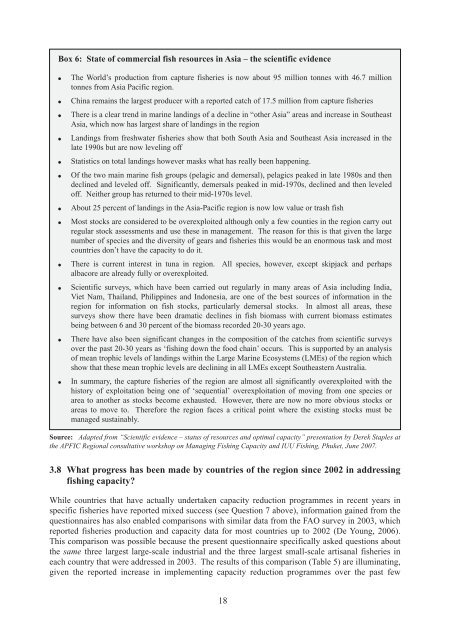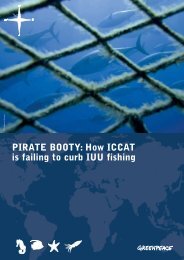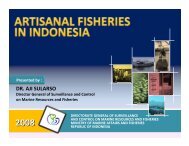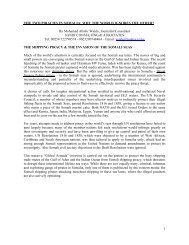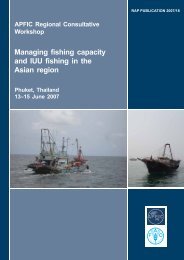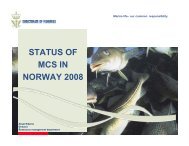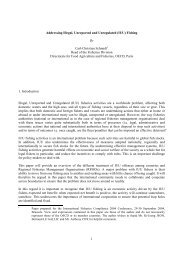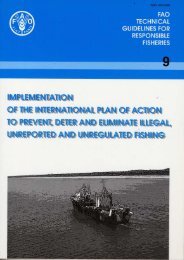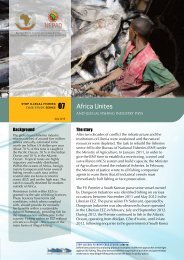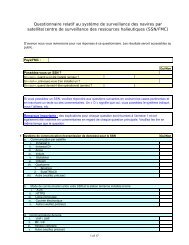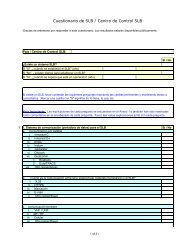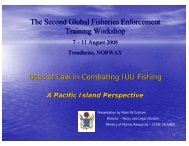Fishing capacity management and IUU fishing in Asia - FAO.org
Fishing capacity management and IUU fishing in Asia - FAO.org
Fishing capacity management and IUU fishing in Asia - FAO.org
Create successful ePaper yourself
Turn your PDF publications into a flip-book with our unique Google optimized e-Paper software.
Box 6: State of commercial fish resources <strong>in</strong> <strong>Asia</strong> – the scientific evidence●●●●●●●●●●●●The World’s production from capture fisheries is now about 95 million tonnes with 46.7 milliontonnes from <strong>Asia</strong> Pacific region.Ch<strong>in</strong>a rema<strong>in</strong>s the largest producer with a reported catch of 17.5 million from capture fisheriesThere is a clear trend <strong>in</strong> mar<strong>in</strong>e l<strong>and</strong><strong>in</strong>gs of a decl<strong>in</strong>e <strong>in</strong> “other <strong>Asia</strong>” areas <strong>and</strong> <strong>in</strong>crease <strong>in</strong> Southeast<strong>Asia</strong>, which now has largest share of l<strong>and</strong><strong>in</strong>gs <strong>in</strong> the regionL<strong>and</strong><strong>in</strong>gs from freshwater fisheries show that both South <strong>Asia</strong> <strong>and</strong> Southeast <strong>Asia</strong> <strong>in</strong>creased <strong>in</strong> thelate 1990s but are now level<strong>in</strong>g offStatistics on total l<strong>and</strong><strong>in</strong>gs however masks what has really been happen<strong>in</strong>g.Of the two ma<strong>in</strong> mar<strong>in</strong>e fish groups (pelagic <strong>and</strong> demersal), pelagics peaked <strong>in</strong> late 1980s <strong>and</strong> thendecl<strong>in</strong>ed <strong>and</strong> leveled off. Significantly, demersals peaked <strong>in</strong> mid-1970s, decl<strong>in</strong>ed <strong>and</strong> then leveledoff. Neither group has returned to their mid-1970s level.About 25 percent of l<strong>and</strong><strong>in</strong>gs <strong>in</strong> the <strong>Asia</strong>-Pacific region is now low value or trash fishMost stocks are considered to be overexploited although only a few counties <strong>in</strong> the region carry outregular stock assessments <strong>and</strong> use these <strong>in</strong> <strong>management</strong>. The reason for this is that given the largenumber of species <strong>and</strong> the diversity of gears <strong>and</strong> fisheries this would be an enormous task <strong>and</strong> mostcountries don’t have the <strong>capacity</strong> to do it.There is current <strong>in</strong>terest <strong>in</strong> tuna <strong>in</strong> region. All species, however, except skipjack <strong>and</strong> perhapsalbacore are already fully or overexploited.Scientific surveys, which have been carried out regularly <strong>in</strong> many areas of <strong>Asia</strong> <strong>in</strong>clud<strong>in</strong>g India,Viet Nam, Thail<strong>and</strong>, Philipp<strong>in</strong>es <strong>and</strong> Indonesia, are one of the best sources of <strong>in</strong>formation <strong>in</strong> theregion for <strong>in</strong>formation on fish stocks, particularly demersal stocks. In almost all areas, thesesurveys show there have been dramatic decl<strong>in</strong>es <strong>in</strong> fish biomass with current biomass estimatesbe<strong>in</strong>g between 6 <strong>and</strong> 30 percent of the biomass recorded 20-30 years ago.There have also been significant changes <strong>in</strong> the composition of the catches from scientific surveysover the past 20-30 years as ‘<strong>fish<strong>in</strong>g</strong> down the food cha<strong>in</strong>’ occurs. This is supported by an analysisof mean trophic levels of l<strong>and</strong><strong>in</strong>gs with<strong>in</strong> the Large Mar<strong>in</strong>e Ecosystems (LMEs) of the region whichshow that these mean trophic levels are decl<strong>in</strong><strong>in</strong>g <strong>in</strong> all LMEs except Southeastern Australia.In summary, the capture fisheries of the region are almost all significantly overexploited with thehistory of exploitation be<strong>in</strong>g one of ‘sequential’ overexploitation of mov<strong>in</strong>g from one species orarea to another as stocks become exhausted. However, there are now no more obvious stocks orareas to move to. Therefore the region faces a critical po<strong>in</strong>t where the exist<strong>in</strong>g stocks must bemanaged susta<strong>in</strong>ably.Source: Adapted from “Scientific evidence – status of resources <strong>and</strong> optimal <strong>capacity</strong>” presentation by Derek Staples atthe APFIC Regional consultative workshop on Manag<strong>in</strong>g <strong>Fish<strong>in</strong>g</strong> Capacity <strong>and</strong> <strong>IUU</strong> <strong>Fish<strong>in</strong>g</strong>, Phuket, June 2007.3.8 What progress has been made by countries of the region s<strong>in</strong>ce 2002 <strong>in</strong> address<strong>in</strong>g<strong>fish<strong>in</strong>g</strong> <strong>capacity</strong>?While countries that have actually undertaken <strong>capacity</strong> reduction programmes <strong>in</strong> recent years <strong>in</strong>specific fisheries have reported mixed success (see Question 7 above), <strong>in</strong>formation ga<strong>in</strong>ed from thequestionnaires has also enabled comparisons with similar data from the <strong>FAO</strong> survey <strong>in</strong> 2003, whichreported fisheries production <strong>and</strong> <strong>capacity</strong> data for most countries up to 2002 (De Young, 2006).This comparison was possible because the present questionnaire specifically asked questions aboutthe same three largest large-scale <strong>in</strong>dustrial <strong>and</strong> the three largest small-scale artisanal fisheries <strong>in</strong>each country that were addressed <strong>in</strong> 2003. The results of this comparison (Table 5) are illum<strong>in</strong>at<strong>in</strong>g,given the reported <strong>in</strong>crease <strong>in</strong> implement<strong>in</strong>g <strong>capacity</strong> reduction programmes over the past few18


